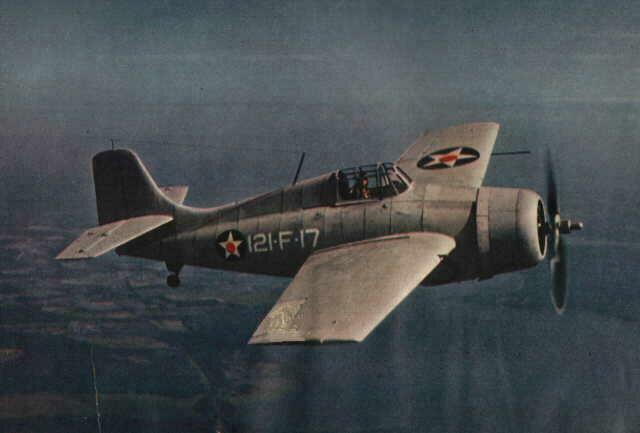U.S. NAVAL AVIATION RESOURCE CENTER > FIGHTERS > WILDCAT > PREVIOUS PAGE
GRUMMAN F4F WILDCAT
Design and Development
Grumman fighter development began with the two-seat Grumman FF biplane. The FF was the first US naval fighter with a retractable landing gear. The wheels retracted into the fuselage, leaving the tires visibly exposed, flush with sides of the fuselage. Two single-seat biplane designs followed, the F2F and F3F, which established the general fuselage outlines of what would become the F4F Wildcat. In 1935, while the F3F was still undergoing flight testing, Grumman started work on its next biplane fighter, the G-16. At the time, the Navy favored a monoplane design, the Brewster F2A-1, ordering production early in 1936, however an order was also placed for Grumman's G-16 (given the navy designation XF4F-1) as a backup in case the Brewster monoplane proved to be unsatisfactory.
It was clear to Grumman that the XF4F-1 would be inferior to the Brewster monoplane, so Grumman abandoned the XF4F-1, designing instead a new monoplane fighter, the XF4F-2. The XF4F-2 would retain the same, fuselage-mounted, hand-cranked landing gear as the F3F, with its relatively narrow track. (The unusual landing gear design was originally created in the 1920's by Leroy Grumman for Grover Loening. It was on all of Grumman's fighter biplanes (from the FF-1 through the F3F) of the 1930s and on the J2F Duck amphibious flying boat as well.) Landing accidents caused by failure of the gear to fully lock into place were distressingly common.

[Source: U.S. Navy]
The overall performance of Grumman's new monoplane was felt to be inferior to that of the Brewster Buffalo. The XF4F-2 was marginally faster, but the Buffalo was more maneuverable. It was judged superior and was chosen for production. After losing out to Brewster, Grumman completely rebuilt the prototype as the XF4F-3 with new wings and tail and a supercharged version of the Pratt & Whitney R-1830 "Twin Wasp" radial engine. Testing of the new XF4F-3 led to an order for F4F-3 production models, the first of which was completed in February 1940. France also ordered the type, powered by a Wright R-1820 "Cyclone 9" radial engine, but France fell before they could be delivered and the aircraft went instead to the British Royal Navy, who christened the new fighter the "Martlet." The US Navy officially adopted the aircraft type on 1 October 1941 as the "Wildcat." Both the British and US Navy's F4F-3's, armed with four .50 in (12.7 mm) Browning machine guns, joined active units in
1940.
The Wildcat's successor was the F6F Hellcat, a complete redesign which dropped Grumman's distinctive, hand-cranked, fuselage-retracting landing gear arrangement, replacing it with landing gear which was hydraulically retracted backward into the wings. The Hellcat, which first flew in 1942, almost completely outclassed the Zero, surprising many Japanese pilots who, on their first encounter with the new fighter, often mistook it for the older, slower Wildcat. (Later in the war, US Navy would also introduce another higher-performance fighter, the Vought F4U Corsair, which could match the top speed of the fastest land-based aircraft of the day.)
Sources:
Wikipedia
U.S. NAVAL AVIATION RESOURCE CENTER > FIGHTERS > WILDCAT > PREVIOUS PAGE

